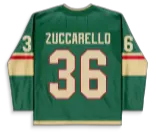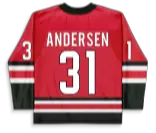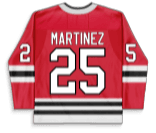Jones suffered an upper-body injury and exited Wednesday's 4-2 loss to the Colorado Avalanche after only 5:56 time-on-ice. He has been placed on Injured Reserve and will be out of the lineup for at least a week, retroactive to November 13th.

Jones suffered an upper-body injury and exited Wednesday's 4-2 loss to the Colorado Avalanche after only 5:56 time-on-ice. He has been placed on Injured Reserve and will be out of the lineup for at least a week, retroactive to November 13th.

With the score tied 2-2, Kuemper exited Wednesday's game against the Colorado Avalanche early in the third period. He was replaced by David Rittich, and the Kings ultimately lost the game 4-2. Kuemper missed some time earlier this season due to a lower-body injury, but it's unclear if his current ailment is related.

Brodin exited Sunday's 2-1 loss to the Chicago Blackhawks after playing 16:38 time-on-ice due to an upper-body injury and did not play on Thursday against the Montreal Canadiens. The 31-year-old Bordin is averaging 22:04 time-on-ice, second most among Minnesota defensemen, and has six points (1G / 5A) in 15 games this season.

Eriksson Ek exited Thursday's game against the Montreal Canadiens in the first period after playing only 3:43 time-on-ice but could be an option to return to the lineup on Saturday against divisional foes, the Dallas Stars. The 27-year-old Eriksson Ek is averaging 17:33 time-on-ice but only has eight points (5G / 3A) through 14 games, a 0.57 point per game pace, after producing at a 0.81 point per game pace over the previous two seasons.

Drouin has not played since the first game of the season, missing 16 consecutive contests, but will return to the lineup on Friday against the Washington Capitals. After several forgetful seasons, the 29-year-old Drouin had a career-high 56 points (19G / 37A) in 79 games last season. That said, at least to start, Drouin will be on the second line, away from his familiar spot alongside Nathan MacKinnon.

Zuccarello exited Thursday's 3-0 win over the Montreal Canadiens in the first period after playing only 3:15 time-on-ice and is expected to miss three-to-four week after undergoing successful surgery. The 37-year-old Zuccarello has not missed a beat, playing predominantly alongside Kirill Kaprizov, scoring 14 points (6G/ 8A). in 16 games this season.

Greenway played a season-low 13:26 time-on-ice on Thursday and exited practice early on Friday due to an undisclosed injury. The 27-year-old Greenway is averaging 16:17 time-on-ice, recording six points (3G / 3A), and 40 hits in 16 games this season.

Point has not played since November 3rd, missing three straight. He will miss a fourth consecutive game on Saturday but appears to be nearing a return, participating in drills at practice on Friday. Before his injury, Point was enjoying another productive campaign, scoring 13 points (8G / 5A) through 12 games.

Thompson scored a goal on Monday, extending his goal-scoring streak to four games, but exited the contest after only 6:49 time-on-ice due to a lower-body injury, did not play on Thursday and will not play on Saturday. The 27-year-old Thompson has been off to a terrific start to the 2024-25 campaign, with 18 points (11G / 7A) in 15 games and could return to the lineup on Wednesday against the Los Angeles Kings.

Jarvis was a late scratch on Monday with his absence not being announced prior to warmups, did not play on Wednesday, and will likely miss some more time due to an upper-body injury. The 22-year-old Jarvis has 11 points (4G / 7A) in 13 games this season.

Letang is battling an illness and will be sidelined for the first time this season. The 37-year-old veteran Letang is averaging 23:12 time-on-ice in his 19th NHL season and has six points (2G / 4A), 20 blocks, and 35 hits in 18 games.

Lizotte missed the first 11 games of the season with a concussion and was struck in the face by a shot in the first period of Wednesday's game, forcing him to leave the game. Matt Nieto will draw into the lineup as Lizotte's replacement.

Originally expected to be a minor injury, Hurricanes' head coach Rod Brind'Amour revealed on Friday that Andersen will be out of the lineup for the foreseeable future. Adding insult to injury for the Hurricanes, Pyotr Kochetkov (undisclosed) suffered an injury on Wednesday and might be unable to suit up on Saturday. Expect Spencer Martin to control the Hurricanes' crease during this uncertain time between the pipes for the Hurricanes.

Kochetkov left Wednesday's game against Utah HC, leaving the contest after allowing three goals on 18 shots (.833 SV%), due to an undisclosed injury. If Kochetkov is unable to play on Saturday, expect the Hurricanes to recall a goalie to serve as the backup to Spencer Martin.

Flyers' captain Couturier is battling a lower-body injury, did not play on Thursday, and is questionable for Saturday's game against the Buffalo Sabres. Morgan Frost drew into the lineup on Thursdays as Couturier's replacement. Couturier has eight points (3G / 5A) in 16 games this season but has been held off the scoresheet in 13.

Ersson was beginning to come to form lately, allowing only seven combined goals in his last five outings (3-0-1), posting a stellar .940 SV%. Expect Ivan Fedotov and Aleksei Kolosov to both see a fair share of the crease over the next 1-2 weeks while Ersson is sidelined.

Martinez has not played since the fourth game of the season, missing 12 straight. The veteran 37-year-old defenseman is averaging 21:02 time-on-ice through four games this season and has tallied one assist, 15 blocks, and one hit.

Eriksson Ek suffered the injury in the first period and was unable to return. We should receive an update on his status ahead of the Wild's game against the Stars on Saturday.

It's unclear when Zuccarello suffered the injury, but he did not join his teammates for the start of the second period. We should receive an update on his status ahead of the Wild's game against the Stars on Saturday.

Joseph suffered the injury early in the second period and was unable to return. We should receive an update on his status ahead of the Blues' game in Boston on Saturday.

The NHL injury report is updated daily so that you can see the latest injury news ahead of puck drop in any of today’s matchups. Seeing timely updates to the NHL injury report can make a major impact on your daily fantasy sports picks and wagers on a particular game. All information provided on the NHL injury report is provided directly by the NHL and each respective franchise to ensure accuracy.
While the minimum amount of time spent on the injured reserve list is seven calendar days, there is no maximum amount of time that a player can be placed on the injured reserve list. If a player is set to be sidelined for longer than 24 calendar days or 10 NHL games, then a club may opt to place them on the long-term injured reserve instead. This allows franchises with the ability to exceed the salary cap while a player is placed on this reserve list.
No injury recovery timeline is the same as another as there are several factors that go into the rehab process for a player being affected by injury. Factors include but are not limited to, injury severity, player injury/medical history, age, as well as the location of the injury. Some injuries are able to clear up in a matter of days, while others may take an athlete out of action for the entirety of a season.